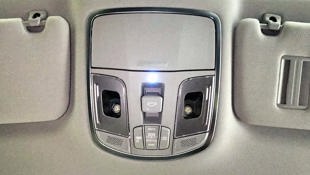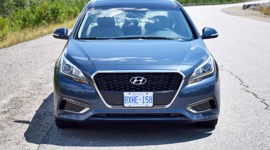 AutoTrader SCORE
AutoTrader SCORE
-
STYLING9/10
-
Safety8/10
-
PRACTICALITY8/10
-
USER-FRIENDLINESS9/10
-
FEATURES9/10
-
POWER8/10
-
COMFORT8/10
-
DRIVING FEEL8/10
-
FUEL ECONOMY9/10
-
VALUE8/10
“Pleasantly stunned” is a good way to describe my initial reaction to testing the front-wheel-drive 2017 Hyundai Sonata Hybrid. If you’re in the market for a midsize sedan with both good drivability and exceptional fuel efficiency, definitely put this one on your list.
As smooth as a Kenny G matinée in Dayton, Ohio
You could argue that the Sonata Hybrid is both middle of the road and front of the line – like the Honda Accord Hybrid was till now. In autoTRADER.ca’s recently conducted comparison test of 2017 midsize sedans the Sonata Hybrid placed first. To be fair, it just barely placed first – the spread in scoring between first and sixth was centimetres wide – and the Accord in the comparison was not a hybrid.
Bottom line, though? This category of cars is crammed with good choices for buyers.
The Sonata is an attractively designed car but the competition is stiff. Head on, its aggressive fascia/grille combo looks (okay, a tiny bit) like a grinning boar with exposed tusks, while the sloping rear windshield suggests the grace of an Olympic diver.
However, the Sonata does not outshine its much sharper competitors like the curvaceous and resplendent Mazda6 and the classic understated simplicity of Volkswagen Passat. Moreover, this tester’s plain grey colour was exciting as Wednesday morning visits to the orthodontist’s office where Do You Know the Way to San José plays softly in the background and people ask each other their plans for the weekend. Workaday.
Which only gave the contrast of the drive that much more impact.
The Sonata’s ride is smooth – as smooth as a Kenny G matinée in Dayton, Ohio. It’s so smooth that a couple of my colleagues thought it bordered on dull. But they regularly test supercars and motorcycles, while most of my own drives are age-inducing detentions in congealing urban traffic. The Sonata Hybrid has a lot to say for itself on city streets and parkways.
First, it handles well. The battery rests beneath the floor of the trunk, making good use of those necessary extra pounds. Who needs all-wheel drive when you have a bit of junk in the trunk? The steering feels slightly flaccid, especially in eco mode, but the sensitivity of the lane assist is so acute, especially on a crowded but quickly moving highway, you get a glimpse into the near-ish future when self-driving cars will make issues like any nuanced feel of the steering obsolete.
Another colleague observed that you wouldn’t even notice this Sonata’s a hybrid by how it drives and sounds. If it weren’t for the slight increase in noise – this is a smooth and quiet ride – and lovely burst of available torque, you’d think it was a regular sedan.
Interesting how hybrid technology is becoming the new middle of the road – but for that exceptional fuel efficiency. The NRCan ratings list the average city/highway/combo at 6.0/5.5/5.8 L/100 km (although I would probably only achieve that going downhill in neutral without any HVAC). The same government source lists the Mazda6 at an inferior 9.1/6.7/8.0 but the Malibu Hybrid at a gob-stopping 4.5/5.5/5.1.
As mentioned, another advantage of a hybrid is the thrust of torque in electric vehicle (EV) mode. The Sonata’s electric battery can operate that system at speeds of up to 120 km/h. Unlike a plug-in, you don’t have to fret over continually recharging the battery. When the juice is depleted, the gasoline engine does double-duty, driving you while also recharging the battery.
The gasoline engine is a 2.0L four-cylinder. Rather than a whiny continuously variable transmission (CVT), the Sonata Hybrid contains a six-speed automatic. As mentioned, the EV can operate at respectable speed if you drive with, quite literally, an environmental awareness. An easy-to-understand dial reports how efficiently you’re driving: charge, eco or Steve. So you can turn the driving experience into a game: how long before you need to refuel?
Here’s an interesting estimate from Hyundai about this car: based on an annual distance of 20,000 km driven at the NRCan rating and a gas pump that remains fixed at $1.09, you’d pay just $1,264 in gasoline.
The green badge Hyundai uses in its marketing is called “blue drive” but a leaf hovers over the letter “e” like the French accent aigu: blué. Blui-AY is the noise it’d make. Which leads to the next point. The complaints beyond it being a safe choice are negligible. In our comparison, it rated lowest for comfort in the back, but those backseats are heated and the rear passenger windows are protected from invasive rays and paparazzi by sunshades.
While we’re in the back: Rather than lifting latches to flatten the 60/40 back seats, you pull levers from inside the trunk. So in case you’re like Jack Bauer and get locked in the trunk, you can escape and save the world faster with a quick tug.
Another minor strike against the Sonata Hybrid was its total cargo space – 380 L is the trunk space with the seats still up. You’ll notice from the photos that the backseats flatten almost flush with the trunk floor, providing more space if needed.
Again, these are minor complaints. Sure the Mazda6 offers 49 L more than the Sonata Hybrid – but 380 L is still a lot of milk and beer.
All in, it packs a lot of value: The base 2017 Sonata Hybrid package with a price $29,649 brings you the hybrid powertrain and a few primo features including heated front seats, heated steering wheel (!), a rearview camera, keyless entry, a leather-wrapped steering wheel, blind-spot detection with rear cross-traffic alert and lane-change assist.
Keep your rearview camera clean and your coffee away from the cloth seats, and you already have yourself a winning combo. That list is ticking all the boxes. But for a little over $4,000, you can add to all that the Limited package which has some of the swoonier features that people love, like leather seating surfaces, heated backseats, an 8.0-inch touchscreen infotainment/navigation system with seven-speaker Dimension audio and those rear window sunshades. There’s also an increase from 16-inch to 17-inch alloy wheels and a panoramic sunroof that promotes a feeling of spaciousness.
Next, the “Ultimate” package is technically the penultimate because the plug-in version of this vehicle is considered another upgrade, the pricier PHEV Ultimate.
Anyway, costing nearly $8,000 more than the base Sonata Hybrid, the Ultimate includes everything it and the Limited package came with, then adds some interesting comfort and safety features including ventilated front seats, rear parking-assistance sensors and adaptive cruise control with stop-and-go capability. (If you become accustomed to the latter but ever neglect to activate it, this trim includes a forward collision warning system, fortunately.)
Other noteworthy safety features include bi-xenon high-intensity headlights with high-beam assist. Xenons last longer than halogen and mimic daylight better, casting a kinder bluish light for easy visibility during night driving and in awful weather – which is safer for you the driver. The high-beam assist is safer for other drivers, detecting oncoming headlights or distant taillights and stopping your high-beams from blinding those other drivers.
The list also includes lane-departure warning, which you can deactivate in case you find it too sensitive. Some people hate it, feeling constantly judged. Again the switch is conveniently close to your left hand. Less time away from reading the road is an important safety feature in itself. It depends on how you like to drive.
Speaking of which, unlike some of its competitors, the difference in tuning between eco, normal and sport modes is not significantly discernible. If you’re looking for three cars in one, this isn’t it. But if you’re looking for smooth hybridity and features out the yin-yang to comfort you while you’re sitting, sucking fumes in traffic, put it on the list.
| Engine Displacement | 2.0L |
|---|---|
| Engine Cylinders | 4 |
| Peak Horsepower | 193 hp @ 6,000 rpm |
| Peak Torque | 140 lb-ft @ 5,000 rpm |
| Fuel Economy | 6.0/5.5/5.8 L/100 km cty/hwy/cmb |
| Cargo Space | 380 L |
| Model Tested | 2017 Hyundai Sonata Hybrid Ultimate |
| Base Price | $37,499 |
| A/C Tax | $100 |
| Destination Fee | $1,795 |
| Price as Tested | $39,394 |
|
Optional Equipment
None
|
|
















































